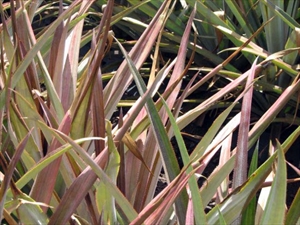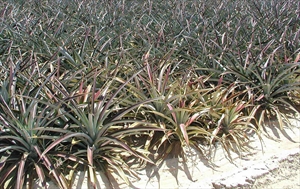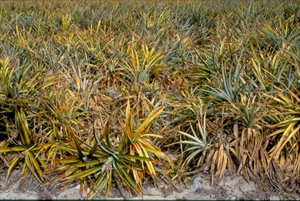Pineapple wilt
Pacific Pests, Pathogens, Weeds & Pesticides - Online edition
Pacific Pests, Pathogens, Weeds & Pesticides
Pineapple wilt disease (380)
Mealybug wilt of pineapple
Asia, Africa, South, North and Central America, the Caribbean, Oceania. It has been recorded from Australia, Cook Islands, and Fiji. Plants from American Samoa and Samoa were found to be infected by two pineapple mealybug wilt-associated viruses (PMWaVs) when maintained in the USDA-ARS National Clonal Germplasm Repository, Hilo, Hawaii.
Pineapple and Pseudoananus. The latter is commonly called the false pineapple, not grown commercially (https://commons.wikimedia.org/wiki/File:Pseudoananas_sagenarius_(8400437895).jpg).
The disease causes a reddening (later pink), severe tip dieback, downward curling and wilting of the leaves; there is also a collapse of the roots (Photos 1-4). Recovery can occur, but fruits are small.
Pineapple wilt appears to be influenced by age of the plants: young plants develop symptoms in 2-3 months; older plants take up to a year.
The disease is associated with the mealybugs, Dysmicoccus brevipes (pink mealybug) and Dysmicoccus neobrevipes (grey mealybug) (see Fact Sheet no. 282). These mealybugs feed on pineapples, acquire Pineapple mealybug wilt-associated virus(es) and then pass the viruses to other plants. Both adults and young do this, but young mealybugs, known as 'crawlers', are the more important. The viruses are acquired after feeding on infected plants for about 72 hours, and the mealybugs remain infective for up to 3 days.
Research into the cause of pineapple wilt shows that one of the viruses, known as PMWaV-2, is the more important, but the presence of feeding mealybugs is also necessary for symptoms to develop. Another, related virus, PMWaV-1, is common, but with or without mealybug feeding its presence does not lead to pineapple wilt, although it may cause yield reduction.
Mealybugs from outside the field that are initially free from infection become established on PMWaV-2 infected plants; these plants develop the wilt disease and secondary spread occurs as the infected mealybugs move to PMWaV-free plants.
Spread of the disease over short distances is by ants and wind. Ants tend the mealybugs collecting honeydew for food and also move the ants from plant to plant. Honeydew is excreted by the mealybugs as they feed on plant sap. The wind carries crawlers between plants and plantations. Long distance spread occurs via all life stages of the mealybugs in consignments of fruit and propagating material traded nationally and internationally.
Pineapple wilt occurs worldwide, is important, although often variable in plantations. This is because the disease depends on the presence of the virus(es), the number of mealybugs present, the length of time they feed, and the presence of ants. Trials in Hawaii showed that if pineapple wilt occurs during the first 3 months of the plant crop, average fruit weight is reduced by 55% compared to plants that remain virus free.
Look for early symptoms - reddening of leaves about halfway up the plant. Look for a change of colour from red to pink, a downward roll of the leaves and dieback of the tip as the leaves collapse. Look for Dysmicoccus mealybugs which spread the wilt disease.
Management of pineapple wilt is difficult. It depends on at least four factors: (i) clean (virus-free) planting material; (ii) removal of weeds; (iii) mealybug control; and (iv) plant density.
NATURAL ENEMIES
There are a large number of predators and parasitoids of Dysmicoccus brevipes, including ladybird beetles, particularly Cryptolaemus species (see Fact Sheet no. 395), and wasps (encyrtids). In many countries, biological control is effective when ants (Pheidole, Iridomyrmex and Solenopsis) are controlled (see Fact Sheet nos. 361, 362&363).
QUARANTINE
Importation of pineapple plants for planting from countries where pineapple wilt occurs should not be permitted unless they are kept under observation in closed post-entry quarantine and tested for pineapple viruses (ampeloviruses and badnaviruses, in the Closteroviridae and Caulimoviridae families, respectively). For fresh fruit, an import risk analysis should be considered where countries are vulnerable to this serious disease, its mealybug vectors and associated ants. Conditions invariably require fresh pineapples to be de-crowned, from registered commercial plantations, fumigated pre-shipment, and inspected on arrival.
CULTURAL CONTROL
The control measures recommended below are for the control of the mealybug, and also for the control of Pineapple mealybug wilt-associated virus(es) that they are thought to spread.
Before planting:
- Use plants that have been treated to free them from virus (hot water or tissue culture) or selected from fields where the incidence of pineapple wilt is low:
- Use plants grown from axillary or apical buds in tissue culture, and tested for the presence of Pineapple mealybug wilt-associated virus(es); OR
- Hot water treatment. Place crowns or slips in water at 50°C for 30 mins. This has been used as a treatment to produce planting material free from Pineapple mealybug wilt-associated virus(es); OR
- Use planting material from wilt-free areas or from fields where there is less than 10% of plants with pineapple wilt. Remove and destroy diseased plants before taking planting material. Additionally, do not take planting material from plants (i) adjacent to those with pineapple wilt, or (ii) that have recovered from symptoms.
- Do not plant new pineapple crops next to those where pineapple wilt occurs. Never plant pineapples on land where the disease was present previously. If crops are heavily infested, remove and burn them, and plough the land, leaving it fallow until all the debris has been plough in or has decomposed.
- Cultivate the soil to destroy colonies of the big-headed ant (Pheidole); nests are near the soil surface, and re-invasion from surrounding areas is slow.
- Decide on plant density. Different bed configurations are used: single, two, or four rows and then a gap. Note, the higher the density (i.e., four adjacent rows before a gap) the easier it is for mealybugs to spread by leaf to leaf contact.
During growth:
- Remove plants with symptoms of pineapple wilt as soon as they are seen and burn them.
- Keep borders free from weeds that may harbour mealybugs and ants.
After harvest:
- Collect and burn all plant residues and, if practical, plough the land.
CHEMICAL CONTROL
- Dip crowns or slips in white oil or horticultural oil to rid the planting material of mealybugs.
- Use ant bait traps that are approved for use in pineapple to allow predators and parasitoids the opportunity to control the mealybugs naturally.
- If more than 3% of the plants have pineapple wilt (or mealybugs are common), use insecticides to control mealybugs and ants. Use diazinon or synthetic pyrethroids. (Note, diazinon is no longer registered in the EU; it is registered for use on pineapples in Australia).
____________________
When using a pesticide, always wear protective clothing and follow the instructions on the product label, such as dosage, timing of application, and pre-harvest interval. Recommendations will vary with the crop and system of cultivation. Expert advice on the most appropriate pesticide to use should always be sought from local agricultural authorities.
AUTHOR Grahame Jackson
Information from Dey KK, et al. (2018) Mealybug wilt of pineapple and associated viruses. Horticulture 4(52). (doi:10.3390/horticulturae4040052); Sether DM et al. (2001) Differentiation, distribution, and elimination of two different Pineapple mealybug wilt-associated viruses found in pineapple. Plant Disease 85:856-864. (https://apsjournals.apsnet.org/doi/pdf/10.1094/PDIS.2001.85.8.856); and J Hu (2002) Detection, Characterization, and Management of Pineapple Mealybug Wilt-Associated Viruses. (http://www2.hawaii.edu/~johnhu/pineapple.pdf); and Subere C et al. (2009) Vector transmission of Pineapple mealybug wilt associated virus-2 by Dymiococcus neobrevipes and Pseudococcus longispinus in Hawaii. Phytopathology 99: S125; and from Subere CVQ et al. (2011) Transmission characteristics of pineapple mealybug wilt associated virus-2 by the grey pineapple mealybugs Dysmicoccus neobrevipes in Hawaii. Proceedings 7th International Pineapple Symposium. Eds.: Abdullah H et al. Acta Hort. 902, ISHS. (https://www.ishs.org/ishs-article/902_47). Photos 1&2 United States National Collection of Scale Insects Photographs, USDA Agriculture Research Service, Bugwood.org. Photos 3&4 United States National Collection of Scale Insects Photographs, USDA Agricultural Research Service, Bugwood.org.
Produced with support from the Australian Centre for International Agricultural Research under project HORT/2016/185: Responding to emerging pest and disease threats to horticulture in the Pacific islands, implemented by the University of Queensland and the Secretariat of the Pacific Community.







